Home Entertainment Blog Archive
Brought to you by your friendly, opinionated, Home Entertainment and Technology writer, Stephen DawsonHere I report, discuss, whinge or argue on matters related to high fidelity, home entertainment equipment and the discs and signals that feed them. Since this Blog is hand-coded (I like TextPad), there are no comments facilities. But feel free to email me at scdawson [at] hifi-writer.com. I will try to respond, either personally or by posting here emails I consider of interest. I shall assume that emails sent to me here can be freely posted by me unless you state otherwise.
This archive is for an uncertain period commencing Thursday, 24 July 2003
 I have queried Warner Vision, the Australian distributor for the majority of DVD Audios, and DTS about the appearance of
Bonus Groups. Now DTS has responded (Warner has told me that they are querying the US company for their titles). Here's what DTS says:
I have queried Warner Vision, the Australian distributor for the majority of DVD Audios, and DTS about the appearance of
Bonus Groups. Now DTS has responded (Warner has told me that they are querying the US company for their titles). Here's what DTS says:
Sorry for the delay in responding to your question.Well that clarifies matters. In this case at least the 'Bonus Group' is there to act as holder for elements of the disc structure, which is something no-one ever need bother themselves with except for the unusually curious. Chances are this also applies to the Warner titles.
Hopefully the answers will satisfy your curiosity regarding 'bonus groups'.First, there is no DVD-A title A Day at the Races. You're maybe refering to A Night At The Opera? [And, of course, DTS is entirely right. In my email I listed the wrong title. Silly me!]
Second, there is no bonus group code. Group 9 is used for some navigation controls.
Third, it might be an interesting idea to use such a bonus group in the future, but it has been found that hidden bonus elements are almost never discovered, so it is preferred that a bonus not be hidden.
I must agree with DTS here that the use of Bonus Groups to hold material of interest to buyers would merely act to deny some, perhaps many, listeners access.
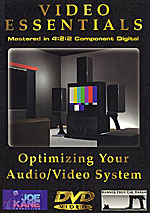 One of my editors has just written to me:
One of my editors has just written to me:
I have a letter from a reader asking where to buy Video Essentials. I bought our NTSC version from online ... I remember receiving something about there being a PAL version, but perhaps it came from Kanes in the US.Unfortunately Joe Kane Productions stopped production of Video Essentials in 2001. While it was being carried by EzyDVD for a while here in Australia, it seems that they have long since sold out. JKP are working on a new version (called Digital Video Essentials) which they claim will be available in PAL, but their web site seems to have been last updated last year some time.
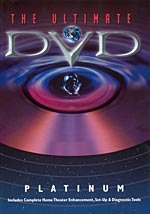 Alternatives are the Ultimate DVD Platinum, but this is
'Out of Stock' at EzyDVD (and like Video Essentials is in NTSC, so the settings made using the disc often don't carry through to PAL playback).
Alternatives are the Ultimate DVD Platinum, but this is
'Out of Stock' at EzyDVD (and like Video Essentials is in NTSC, so the settings made using the disc often don't carry through to PAL playback).
Alternatively, and perhaps more usefully, a number of 'THX' logoed PAL DVDs have a system setup section. This is normally accessible through the 'Setup' menu. Titles include Star Wars: Episode 1, The Phantom Menance; Star Wars: Episode 2, Attack of the Clones and Pearl Harbour. Unfortunately these titles don't have the colour filter that assists in nailing down this aspect of performance properly.
From time to time I Google for a PAL setup DVD, but the only ones that seem like they may possibly meet my requirements seem to be professional-level German ones ... and I can't read German.
UPDATE (Thursday, 31 July 2003, 1:16 pm): The THX glasses can be purchased here.
Through some silly oversight, I didn't have
Perreaux listed under the hardware links. Well, that's fixed now. Perreaux is a New Zealand brand of electronics, especially well respected for its 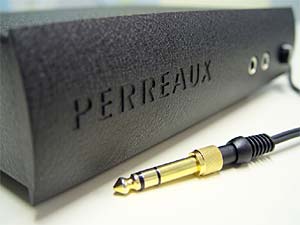 amplifiers. Incredibly it has been around since 1974 and, I'm fairly certain, far exceeds any
Australian amplifier brand in sales reach. It has now added to its range the
SHX-1 headphone amplifier.
amplifiers. Incredibly it has been around since 1974 and, I'm fairly certain, far exceeds any
Australian amplifier brand in sales reach. It has now added to its range the
SHX-1 headphone amplifier.
Why a headphone amplifier? While the great majority of audiophiles prefer to use speakers, some actually prefer headphones. There are advantages to these. For one thing, no speaker setup can match a fine pair of headphones for delivering detail. Regardless of how good the speakers are. The reason is simple: the listening room. There will always be reflections that will cause sounds to mask each other. This doesn't happen with headphones.
Me? I only use headphones as a last resort, or to clarify something that I'm hearing from a recording. Headphones are the ultimate in unrealistic sound. The stereo stage cannot be resolved with headphones (unless you are using some pretty nifty DSP processing which merely aims to replicate the affects of a room on sound, which rather misses the point). Instead, you get a spread of intruments and vocals through your brain.
I'm sure, though, that Perreaux will have implemented a headphone amplifier as well as anyone could. One thing to note on portable audio gear (Walkmans, MP3 players and so forth) is that very few of them do bass well. Virtually all of them roll off the bass, typically to between -7dB and -20dB at 20 hertz. It comes with the territory. The low voltage power sources just can't deliver the current necessary to sustain high bass levels into low impedance headphones. Things are better if your headphones offer a hundred or more ohms impedance, but most these days are around 32 ohms. This is highly unlikely to be a problem with the SHX-1, nor indeed for most headphone outputs on equipment driven by mains power.
Even very clever people, when talking about things outside their speciality, sometimes get things wrong. I'm reading Professor Mike Orkin's What Are The Odds? and discover on page 15 this statement:
Just as electricity follows the path of least resistance, chance follows the path of most likely.Nicely said, but the first clause is just not so. If there are two paths, both with equal voltage applied, then the electricity will take both paths. It will take them in inverse proportion to their resistances. So if one path has a resistance of three ohms and the other six ohms, then twice as much current will flow along the three ohm path as that which flows along the other.
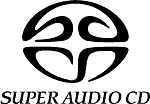 Multichannel Super Audio CD (SACD) simply does not work properly in most home systems. And we are in the hands of Sony and Philips, it seems, until it does.
Multichannel Super Audio CD (SACD) simply does not work properly in most home systems. And we are in the hands of Sony and Philips, it seems, until it does.
SACD is duking it out with DVD Audio as the high resolution music format of choice. I'll post in the next few days on the pros and cons of the two of them. But here's one major difference: DVD Audio simply extends the familiar PCM format from the compact disc. The world has thirty or more years experience dealing with PCM (Pulse Code Modulation). Computer sound cards use PCM. Processing to do just about anything is readily available. All it takes is a bit of will to do nearly anything you want to a PCM signal.
But SACD doesn't use PCM. It uses 'Direct Stream Digital' which is a single bit, high data rate system. There is almost no equipment for doing stuff to a DSD signal. So processing of such signals will, for the forseeable future, remain restricted to what Sony and Philips (and anyone they license) deign to give us.
DSD has gained somewhat of a reputation for a 'more natural sound' than DVD Audio, although I think this is silly because there are no discs which can be compared. (And don't say Telarc's 1812 Overture because this was actually recorded in DSD; the DVD Audio version has been converted from the DSD recording.)
Be that as it may, proper surround playback demands that either all five speakers be the same distance from the listener, or that the system allows time alignment to adjust for the different speaker distances. Very few people have, or even can have, the surround speakers at the same distance as the front speakers without compromising the front stereo stage.
From the equipment-maker's perspective, there are only two realistic ways to accomplish time alignment on DSD signals: get DSD decoders from Sony or Philips which provide this function, or convert the signal to PCM and do it yourself. It seems that there are no such chips yet. And to convert to PCM would attract derision from the audiophile crowd because that would cancel the alleged benefits of DSD.
So I guess we'll just have wait until Sony and Philips come up with the goods.
Declan McCullagh's invaluable Politech mailing list is carrying an item by a poor chap who purchased a pile of music from Apple's Music Store. No problems until two things happened: he moved from the US to Canada, and his computer system crashed. When he restored his system and attempted to re-authorised his purchased music, it was rejected. The purchases are only valid in the United States.
This is, of course, thanks to Digital Rights Management (DRM) built into many new digital music formats.
Moving country may not be the only difficulty. What if you've forgotton, or misplaced, your authorisation credentials, and your system crashes, or you're migrating to a new system? What if you want to listen to a track on your notebook computer, but discover that you've 'logged the track out' (to use Sony's terminology for its Network Walkman players) to a portable gadget ... and the gadget is 3,000 kilometres away from you?
For all their benefits over MP3 in terms of sound quality, especially at higher levels of compression, Windows Media, AAC, ATRAC3 and any forthcoming audio formats are simply not going to cut it, thanks to the convenience factor.
Eventually content owners are going to have to come to terms with the fact that controls do not work. DVD rippers are readily available. Compact Discs (which will not be displaced as the principal carrier of music for many years) cannot be copy protected, despite efforts to the contrary, and Region 4 coding is either inconvenient or laughable.
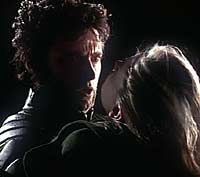 I've just been examining the structure of the Region 2/4 X-Men Limited Edition DVD. Several things stood out. The movie itself resides in Title 2 (there are 42 Titles!), and also in Titles 1 and 3. Title 3 is the branching version which adds in about ten minutes of deleted scenes, while Title 1 is generally inaccessible. Now Title 1 has the whole movie, just like Title 2, but tacked on the end are five more Chapters, which in order replicate Chapters 5, 6, 7, 8 and 11. Weird.
I've just been examining the structure of the Region 2/4 X-Men Limited Edition DVD. Several things stood out. The movie itself resides in Title 2 (there are 42 Titles!), and also in Titles 1 and 3. Title 3 is the branching version which adds in about ten minutes of deleted scenes, while Title 1 is generally inaccessible. Now Title 1 has the whole movie, just like Title 2, but tacked on the end are five more Chapters, which in order replicate Chapters 5, 6, 7, 8 and 11. Weird.
Also of note is the low bit rate of the movie itself. Sure, it looks good, but how much better would it be if the bite rate were bumped up from 4.68Mbps (which includes the 384kbps audio)? Especially as the whole disc has just 7.1GB of data (you can have up to 8.5 on a dual layer DVD).
There are also two easter eggs. There are seven preliminary character drawings, accessible by selecting Wolverine's dog tag on the Art Gallery menu, and a 35 second spoof in Title 15, where Spider Man walks in on a scene. You get at this one by selecting the Knight drawing on the Trailers menu.
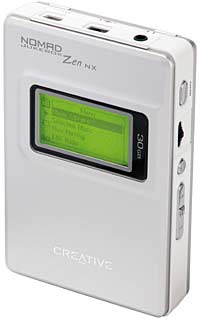 Well, the price is right. Creative's Nomad Jukebox Zen needs to shorten its name to match its price, to really kill the Apple iPod. What's wrong with just the plain old Creative Zen? And without iPod's beaut non-moving control wheel on the front, navigation will never be as easy.
Well, the price is right. Creative's Nomad Jukebox Zen needs to shorten its name to match its price, to really kill the Apple iPod. What's wrong with just the plain old Creative Zen? And without iPod's beaut non-moving control wheel on the front, navigation will never be as easy.
But look at that price: $499 for the 20GB version, $599 for 30GB.
I haven't reviewed the Zen yet, although I've done a couple of versions of the CD player-sized Jukebox. These have worked rather nicely and have the added advantage of PCM recording (something missing, I think, from the Zen). Still, if you want to record, might as well get a proper recorder.
Creative's software is a bit off-putting. Monstrously large and, during one of my reviews, rather clunky. Still, the nice thing about hard-disk based MP3 players is that you generally only need to load each song once, and then it stays there forever.
Most MP3 players still rely on good old USB 1.x, which just can't cut it against the iPod's FireWire. Last time I reviewed the Jukebox, the file transfer time on a 128kbps MP3 was four per cent of the track playback time. For the iPod, it was just 0.34% or, say eight-tenths of a second for a typical four minute track. The USB 2.0 offered by the Zen ought to come very close indeed. I'll have get one and check it out.
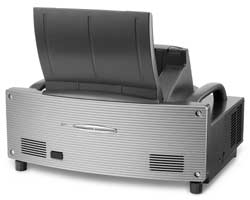 NEC's press release on its new
WT600 projector had me puzzled. Claiming an ultra-short-throw, it said that a 100 inch picture could be produced at a range of just 65cm, and a 40 inch picture at 6cm. My eye skipped lightly over two different things to focus on that 6cm claim. A 40 inch picture at a range of less than three inches? Come on!
NEC's press release on its new
WT600 projector had me puzzled. Claiming an ultra-short-throw, it said that a 100 inch picture could be produced at a range of just 65cm, and a 40 inch picture at 6cm. My eye skipped lightly over two different things to focus on that 6cm claim. A 40 inch picture at a range of less than three inches? Come on!
Out comes the calculator. You can typically treat projectors as a point source, at least for approximate calculations. So if it produces a 100 inch picture at 65cm, then it must produce a 40 inch pictures at 40/100*65 = 26cm. Ah hah. Another triumph! Clearly the press release had omitted the '2' from the front of the '6'. I still hadn't twigged that even 65cm (just over two feet) is a ludicrously short range.
I reported the 'correction' to NEC's PR person, who promptly replied that the figures were right, and she supplied another couple of figures. Determined to prove my point, I sketched out a graph, expecting a straight line pointing at the graph's origin. Oh oh. No way. The graph intersected with the origin at just under 40 inches. How can this be? It would imply that the projector has a huge lens!
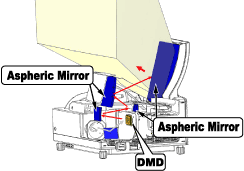 Which, in effect, it does. Because it uses a mirror to direct the light, not a lens.
Which, in effect, it does. Because it uses a mirror to direct the light, not a lens.
This thing has definite potential. Instead of a projector hovering above your head, it can be up nice and close to the screen ... and well away from you. You can probably put some kind of noise reduction around it as well.
The NEC WT600 is 4:3 XGA, which means 1:1 vertical mapping for PAL widescreen, uses a DMD for a claimed 3,000:1 contrast and an ANSI lumens level that, I hope, is far too high.
The only problem I see is that at the extreme angle from which it projects, some high gain screens may not work well with it (since they are designed to accept and reflect light optimally from directly in front).